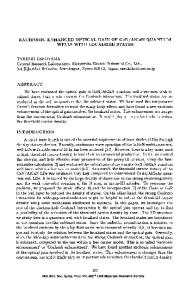Optical Study of Localized and Delocalized States in GaAsN/GaAs
- PDF / 195,544 Bytes
- 6 Pages / 612 x 792 pts (letter) Page_size
- 8 Downloads / 492 Views
Y5.68.1
Optical Study of Localized and Delocalized States in GaAsN/GaAs Z.Y.Xu,1 X. D. Luo,1 X.D.Yang,1 P.H.Tan,1 C. L. Yang,2 W. K. Ge,2 Y.Zhang,3 A.Mascarenhas,3 H.P.Xin,4 and C.W.Tu4 1
Institute of Semiconductors, CAS, Beijing, 100083, China. Email: [email protected]
2
Department of Physics, Hong Kong University of Science & Technology, Hong Kong,
3
National Renewable Energy Laboratories, Tallahassee, Florida 32306
4
Department of Elec. Engineering, University of California, California 92093
ABSTRACT Taking advantages of short pulse excitation and time-resolved photoluminescence (PL), we have studied the exciton localization effect in a number of GaAsN alloys and GaAsN/GaAs quantum wells (QWs). In the PL spectra, an extra transition located at the higher energy side of the commonly reported N-related emissions is observed. By measuring PL dependence on temperature and excitation power along with PL dynamics study, the new PL peak has been identified as a transition of the band edge-related recombination in dilute GaAsN alloy and delocalized transition in QWs.
Using selective excitation PL we further attribute the localized
emission in QWs to the excitons localized at the GaAsN/GaAs interfaces. This interface-related exciton localization could be greatly reduced by a rapid thermal annealing. INTRODUCTION GaAsN semiconductor alloys grown on GaAs substrate have attracted much attention due to their unusual physical properties and potential applications in long wavelength optoelectronic and photonic devices [1-5]. Understanding the emission mechanism in these materials is very important, not only from the viewpoint of physical interest but also for the device design. In recent optical studies, the strong action of N atoms in GaAs and the large strain between GaAsN and GaAs have been shown to make the absorption and photoluminescence (PL) very complicated [6-9]. In PL measurements, N-related pair states, cluster states, localized band-tail states and delocalized states were reported in various experiments. In this work, we use photoluminescence (PL) and time-resolved PL to study exciton localization and delocalization effects in GaAsN/GaAs system. EXPERIMENTAL DETAILS The diluted GaAs1-xNx samples investigated here were grown by gas-source MBE on
Y5.68.2
semi-insulating (001) GaAs substrates using a RF nitrogen radical beam source. The epilayer thickness of the samples is nominally 400 nm. Four samples (#2658 (x~0.10%), #2846 (x~0.22%), #2847 (x~0.36%), and #2848 (x~0.62%)) were used in this study. GaAsN/GaAs quantum well (QW) samples were also grown by MBE using a DC active nitrogen plasma as the nitrogen source. The structure contains a 500 nm GaAs buffer layer, a GaAs0.985N0.015 QW layer of different thickness and a 100 nm GaAs cap layer. Detailed growth process was described elsewhere[7,10]. Rapid thermal annealing (RTA) was carried out in a flowing N2 gas ambient on the samples covered with a protective GaAs wafer. In the PL measurements, a Ti:sapphire laser, in either cw mode or mode-locked mode,
Data Loading...








